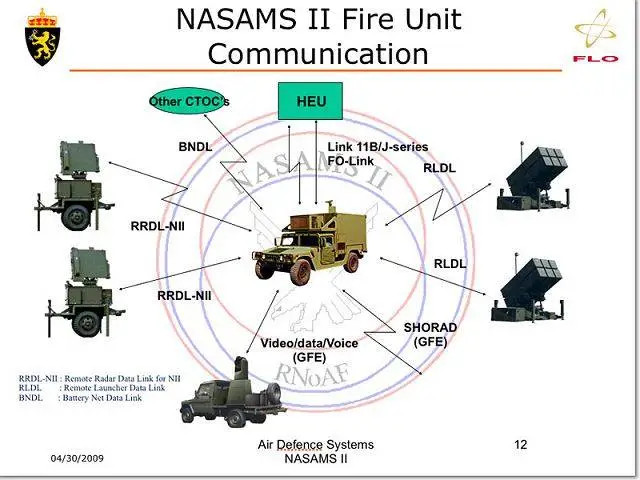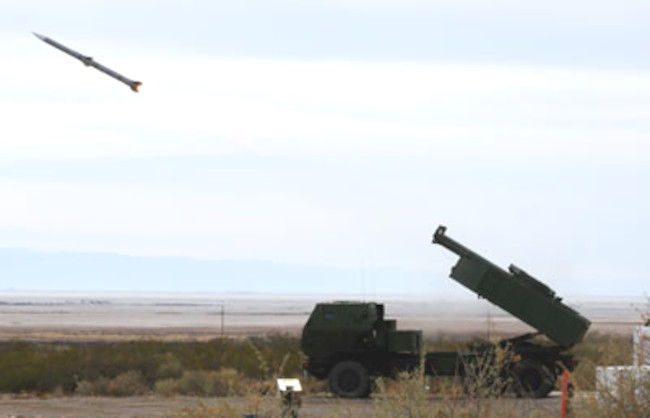The Pentagon has announced a new military assistance package for Ukraine, the largest to date with a whopping value of nearly $3 billion, as the country marks six months since the start of Russia’s all-out invasion and the 31st anniversary of its independence from the Soviet Union. The new tranche of aid from the U.S. government includes six more National Advanced Surface to Air Missile Systems, or NASAMS, and an unspecified number of counter-drone systems called Vampire, along with more artillery ammunition, radars, and other materiel. The planned transfers are expected to occur over the course of a number of years, underscoring a new and important focus on bolstering the Ukrainian military’s capabilities in the longer term, regardless of how the current conflict might evolve.
The U.S. government is providing the new aid, worth around $2.98 billion in total, via the Ukraine Security Assistance Initiative (USAI). This is a U.S. military assistance mechanism specifically established for Ukraine, which predates the current conflict and is separate from the deliveries of weapons and other materiel that President Joe Biden has authorized using his so-called “drawdown authority.” Drawdowns involve transfers of items from within the U.S. militay’s inventory, while USAI funds direct purchases of new weapons and other equipment, as well as training, maintenance, and other support services, on Ukraine’s behalf.
“On behalf of all Americans, I congratulate the people of Ukraine on their Independence Day. Over the past six months, Ukrainians have inspired the world with their extraordinary courage and dedication to freedom,” President Biden wrote in a statement that also touched on the new military aid earlier today. “They have stood resolute and strong in the face of Russia’s full-scale invasion of Ukraine. And today is not only a celebration of the past, but a resounding affirmation that Ukraine proudly remains – and will remain – a sovereign and independent nation. The United States of America is committed to supporting the people of Ukraine as they continue the fight to defend their sovereignty. “
A Pentagon press release listed the following items as being included in the new nearly $3 billion aid package:
- Six more NASAMS along with unspecified “additional munitions” for them
- “VAMPIRE Counter-Unmanned Aerial Systems”
- Unspecified Laser-guided rocket systems
- Up to 245,000 rounds of 155mm artillery ammunition
- As many as 65,000 rounds of 120mm mortar ammunition
- Up to 24 unspecified counter-artillery radars
- Additional RQ-20 Puma drones and “support equipment” for a previously announced transfer of Scan Eagle unmanned aircraft
- Funding for training, maintenance, and sustainment.
The inclusion of six more NASAMS, as well as more munitions for them to fire, is particularly significant. The U.S. government had previously announced plans to transfer two NASAMS to Ukraine.
It remains unclear how the NASAMS heading to Ukraine will be configured. A number of different versions of the system exist now, made up of different combinations of launchers, radars and other sensors, and command and control nodes. For instance, certain variations of NASAMS incorporate missile launchers mounted on Humvees or other light vehicles. Tests have also been conducted of the M142 High Mobility Artillery Rocket System (HIMARS) vehicle, which Ukraine has now received at least 16 of, as a launch platform for the AIM-120 Advanced Medium Range Air-to-Air Missile (AMRAAM), which could be utilized with NASAMS.


The same questions apply to the “munitions” the U.S. has said it will send along with these systems. NASAMS can fire versions of the radar-guided AMRAAM, including a new extended range derivative optimized for use in the ground-launched roles, as well as the AIM-9X Sidewinder heat-seeking missile, and more.

As such, depending on how it is configured, NASAMS has the ability to provide various levels of both short and medium-range air defense capacity. It does seem most likely that Ukraine’s NASAMS will fire AIM-120s, at least initially, as there is a solid supply chain for these missiles and the country is most in need now of extra area air defense capacity.
With eight total systems, the Ukrainian armed forces will be able to provide immediate protection against various aerial threats, including aircraft, cruise missiles, and drones, at a greater number of total locations, such as cities or specific high-value facilities. Beyond all this, NASAMS, which was developed jointly by American defense contractor Raytheon and Norwegian firm Kongsberg, is simply more modern and capable all around than Ukraine’s existing Soviet-era short and medium-range surface-to-air missile systems.
The question now is how fast the U.S. government might be able to facilitate the delivery of these systems. A senior U.S. defense official said last week that Ukraine is expected to take delivery of the first two systems, which were also purchased via the USAI, in the next two to three months. Whether or not this reflects some degree of spare production capacity available at Raytheon and/or Kongsberg is unclear. Purchasing previously unsold systems that Raytheon or Kongsberg already had on hand or acquiring them through the redirection of systems already being produced for other customers, or directly from third parties, are also options. The U.S. military does not currently have an active acquisition pipeline for complete NASAMS of its own that could have leveraged in this case.
As already noted, the NASAMS for Ukraine are not coming from American stocks, either. This makes sense given that the U.S. military’s current arsenal of NASAMS, which is small and almost exclusively positioned to provide critical air defense coverage around Washington, D.C., and the greater National Capital Region.
Concerns about industrial base capacity to sustain deliveries of key weapon systems to Ukraine, especially missiles and other guided munitions, have already emerged. Military aid to Ukraine has already prompted pushes to increase production and expand supplier bases for the Javelin shoulder-fired anti-tank missile and the Stinger shoulder-launched surface-to-air missile, the latter also being referred to as Man Portable Air Defense System (MANPADS). There are now similar discussions being had in regards to the Guided Multiple Launch Rocket System (GMLRS) rockets that Ukraine has received for use with its growing fleet of M142 High Mobility Artillery Rocket Systems (HIMARS) and variants of the M270 Multiple Launch Rocket System (MLRS).

The Vampire counter-drone systems, something at least not mentioned by name as having been included in any previous U.S. military aid packages, are also interesting. It was not initially clear what this system was and some initial reports erroneously said it was another type of drone – apparently mistaken for the unrelated U.K. Royal Navy program to develop ship-launched drones called Project Vampire – rather than something to knock them down.
L3Harris subsequently confirmed to Breaking Defense that the system in question is a version of the company’s new Vehicle-Agnostic Modular Palletized ISR Rocket Equipment system, or VAMPIRE. At least as it has been publicly shown so far, VAMPIRE consists of a four-round launcher for 70mm laser-guided rockets, such as the Advanced Precision Kill Weapon System II (APKWS II), as well as a sensor turret with electro-optical and infrared cameras, centralized control system, and dedicated power supply.
L3Harris does not appear to have specifically mentioned VAMPIRE having a counter-unmanned aerial systems (C-UAS) capability in the past, but does say that it “can be configured to meet customer-specific requirements.” A company promotional video for the system, seen below, also says that “L3Harris Advanced Video Tracking maintains [a] lock on moving targets” while showing a clip of an MQ-9 Reaper viewed through an infrared camera and that it offers “precision-strike capability with ground-to-ground or ground-to-air munitions.”
Using the system against drones would not necessarily be a stretch, at least when it comes to engaging relatively slow-moving types. The U.S. Air Force has demonstrated the ability to use air-launched APKWS II rockets against surrogates for subsonic cruise missiles, a capability that The War Zone has noted could be employed against unmanned aircraft, as well.

In addition, as its name indicates, VAMPIRE is a self-contained palletized system, allowing it to be readily fitted to various vehicles. L3Harris has publicly displayed a pickup truck-mounted version. Ukrainian forces already operate pickup trucks armed with various kinds of missiles and rocket launchers, among other weapons.
It’s also worth remembering that the U.S. military first publicly announced plans to transfer APKWS II rockets to Ukraine back in May, but without any details about what would fire them or how they would otherwise be employed. More recently, the German government revealed its own plans to supply pickup trucks with 70mm rocket launchers and laser-guided rockets to go with them. Though we don’t know if any of this is directly related, these past announcements are certainly newly interesting in light of the inclusion of VAMPIRE in the new U.S. aid package.
When it comes to the U.S. government’s plans to send more artillery and mortar ammunition, as well as counter-battery radars that are used to help locate enemy artillery units so they can then be attacked, this underscores the continued importance of rocket artillery, howitzers, and other indirect fire weapons on both sides of the conflict. The additional RQ-20 Puma drones could be tasked to help find hostile artillery batteries, among other things, too. Ukrainian and Russian forces are already making extensive use of unmanned aircraft to help spot artillery fire.

Beyond its basic contents, the massive new USAI aid package for Ukraine highlights how U.S. officials have been working with their Ukrainian counterparts on more forward-looking assistance that the country will need going forward regardless of when, how, and even if the current conflict is resolved.
“This will allow Ukraine to acquire air defense systems, artillery systems and munitions, counter-unmanned aerial systems, and radars to ensure it can continue to defend itself over the long term,” President Biden said in his statement.
“This USAI package, which is being announced on Ukraine Independence Day, underscores the U.S. commitment to supporting Ukraine over the long term – representing a multi-year investment to build the enduring strength of Ukraine’s Armed Forces as it continues to defend its sovereignty in the face of Russian aggression,” the Pentagon press release said. “This announcement represents the beginning of a contracting process to provide additional priority capabilities to Ukraine in the mid- and long-term to ensure Ukraine can continue to defend itself as an independent, sovereign and prosperous state.”
The longer-term focus is significant in its own right. Many, including The War Zone, have highlighted how even if some kind of peace between Russia and Ukraine were to be achieved tomorrow, that the risk of subsequent conflicts would almost certainly remain high. With that in mind, the Ukrainian military has to be planning now for how it will rebuild itself and modernize its capabilities in any post-conflict environment, or even a largely frozen conflict situation, as had already existed prior to Russia’s all-out invasion in February, in order to bolster its ability to deter and defend against future invasions.
“I know this independence day is bittersweet for many Ukrainians as thousands have been killed or wounded, millions have been displaced from their homes, and so many others have fallen victim to Russian atrocities and attacks. But six months of relentless attacks have only strengthened Ukrainians’ pride in themselves, in their country, and in their thirty-one years of independence,” Biden wrote in his statement today. “Today and every day, we stand with the Ukrainian people to proclaim that the darkness that drives autocracy is no match for the flame of liberty that lights the souls of free people everywhere. The United States, including proud Ukrainian-Americans, looks forward to continuing to celebrate Ukraine as a democratic, independent, sovereign and prosperous state for decades to come.”
The U.S. government has certainly signaled its commitment in this regard with the announcement of the huge new military aid package today.
Contact the author: joe@thedrive.com
